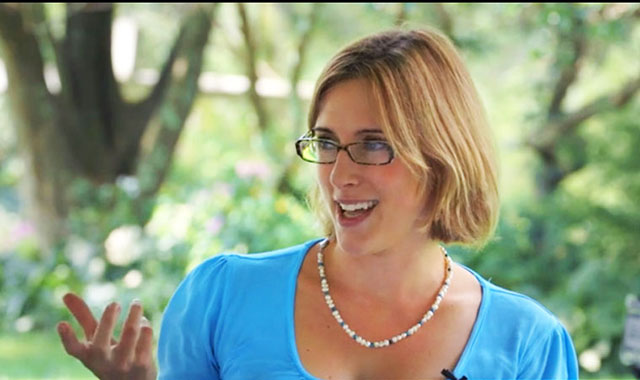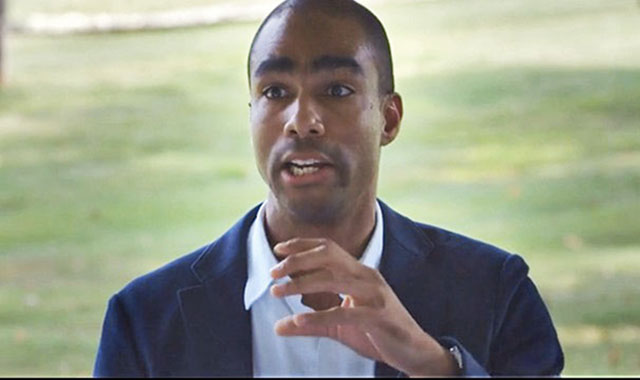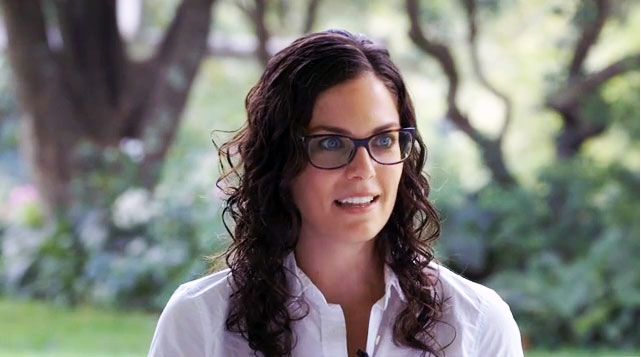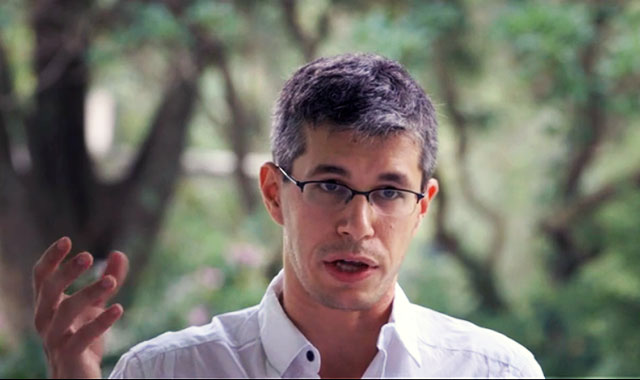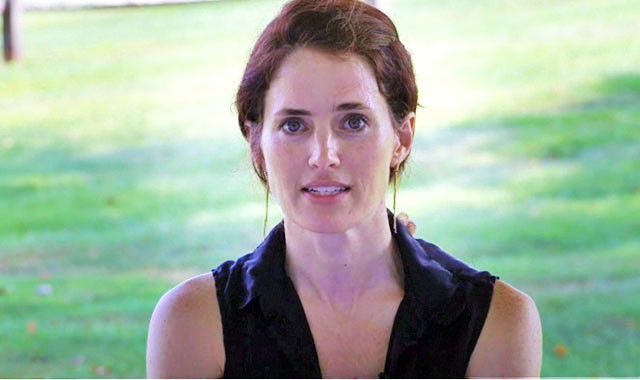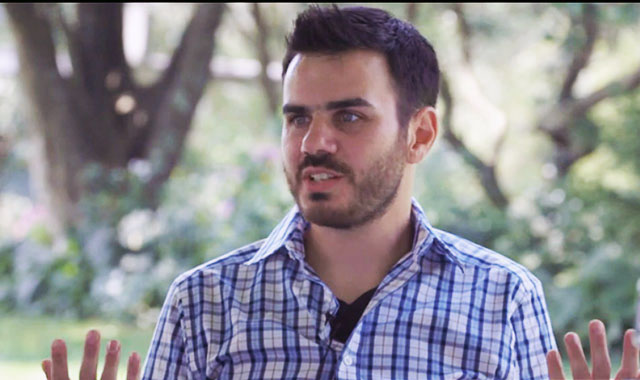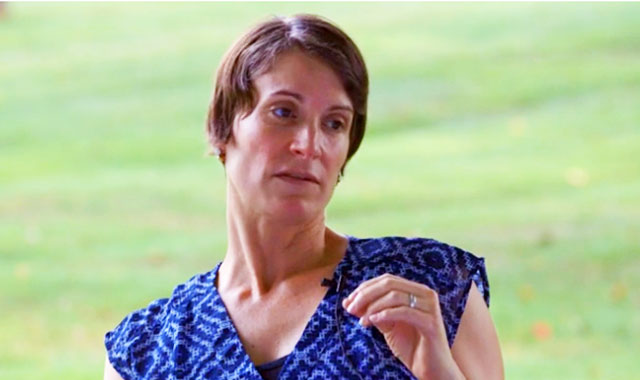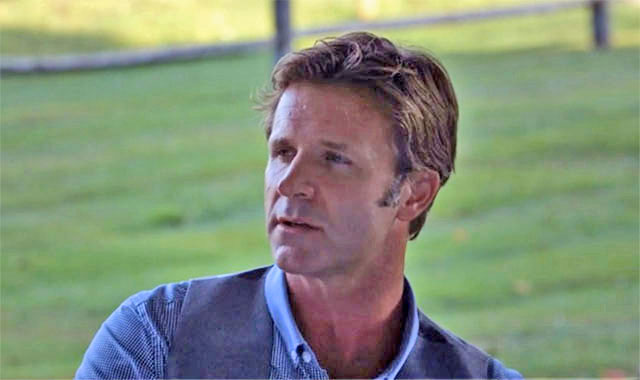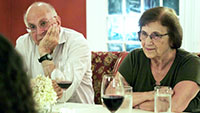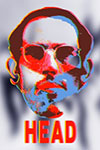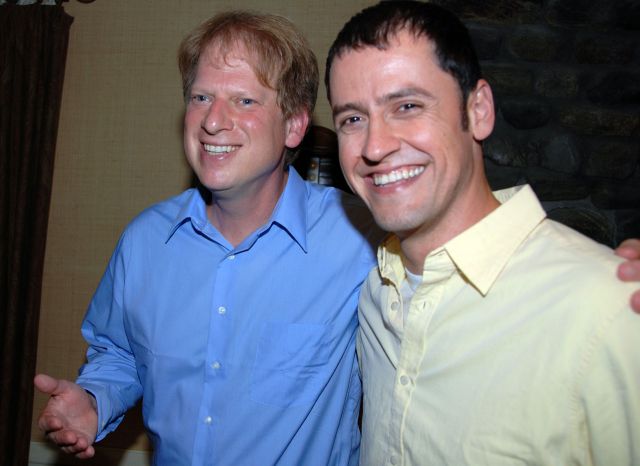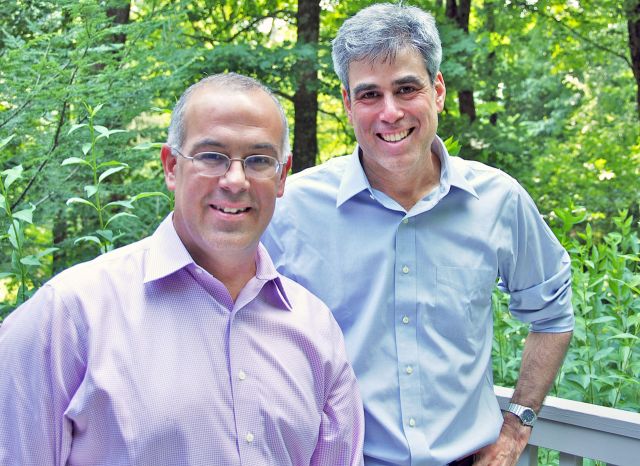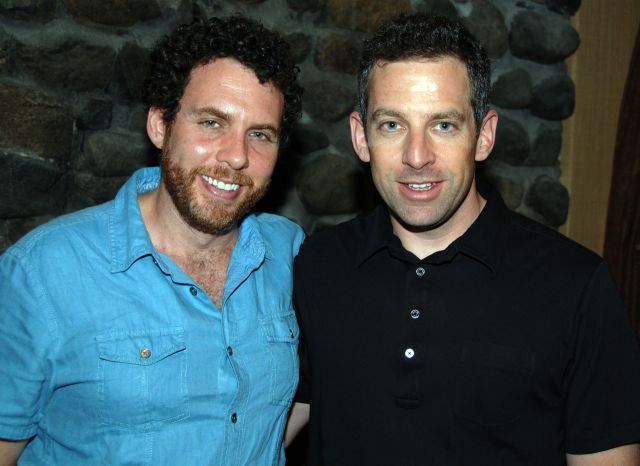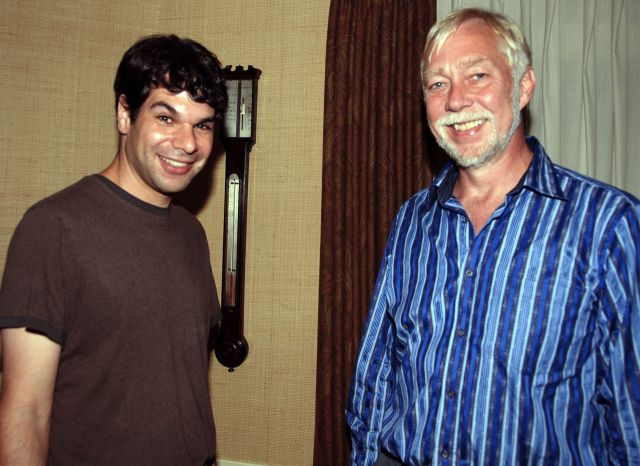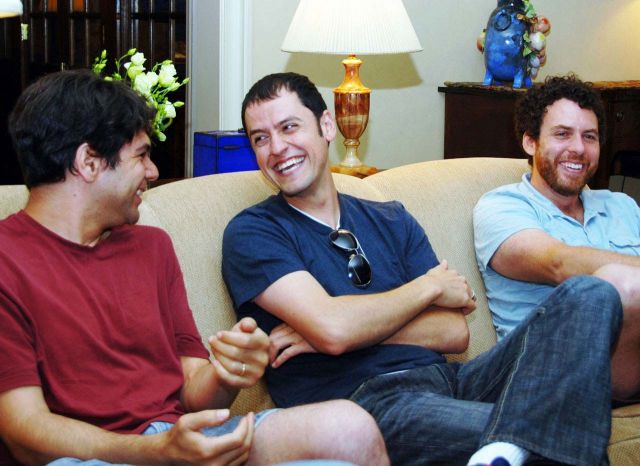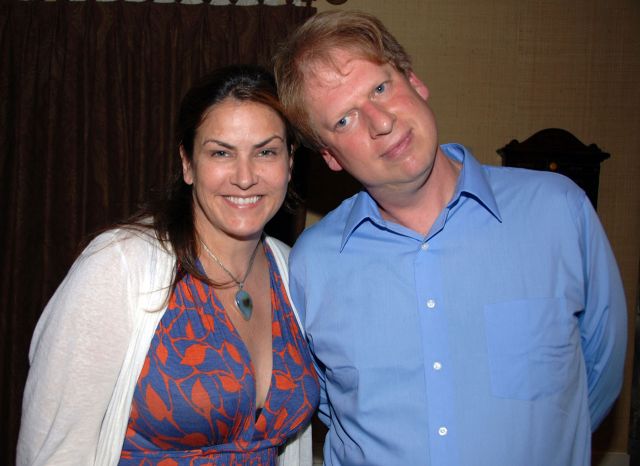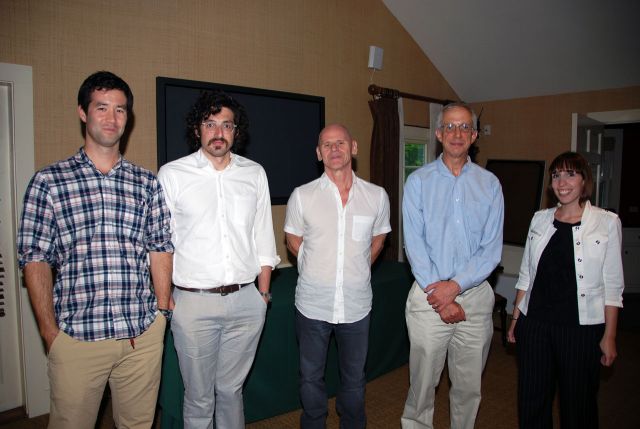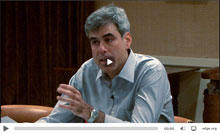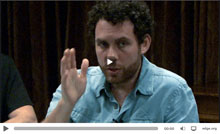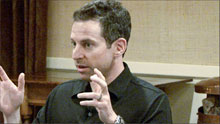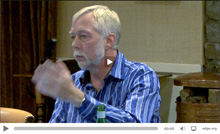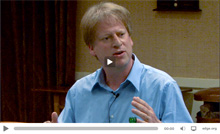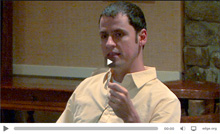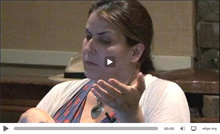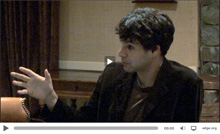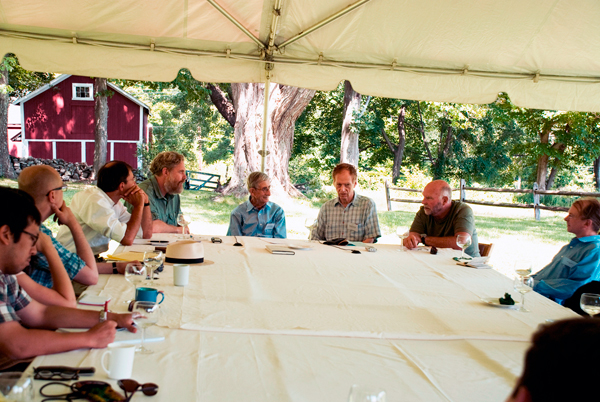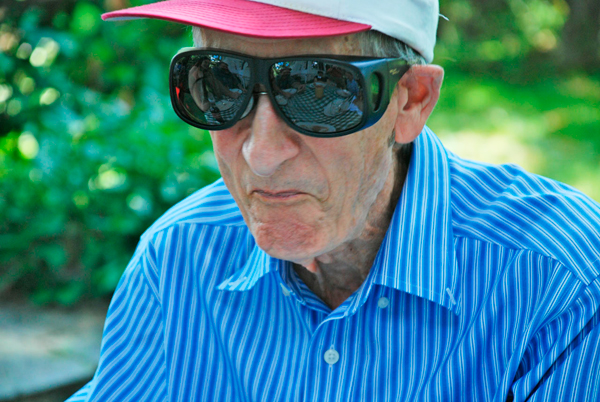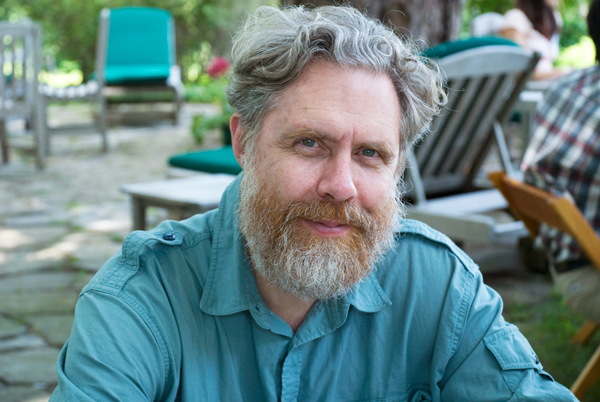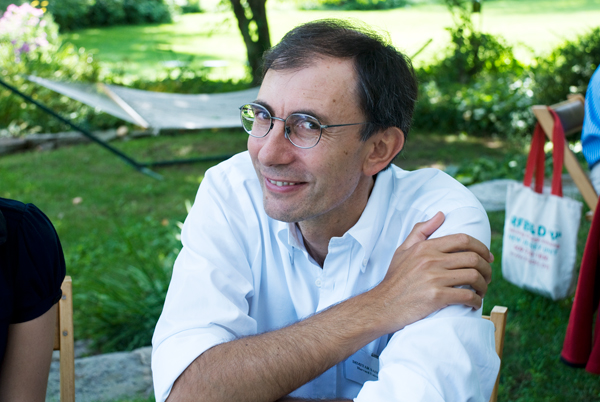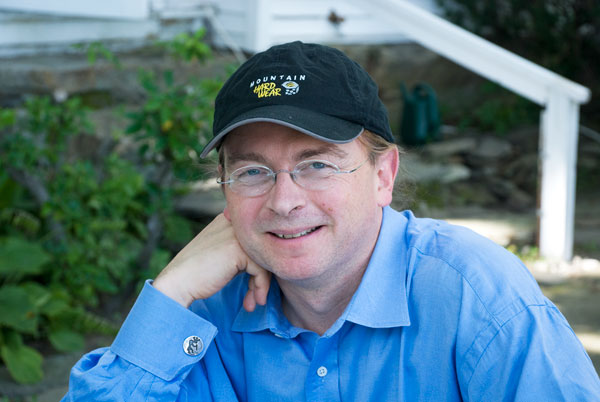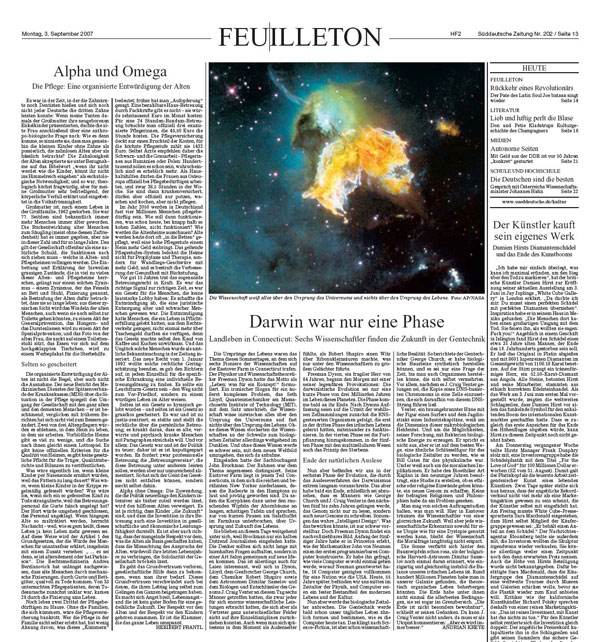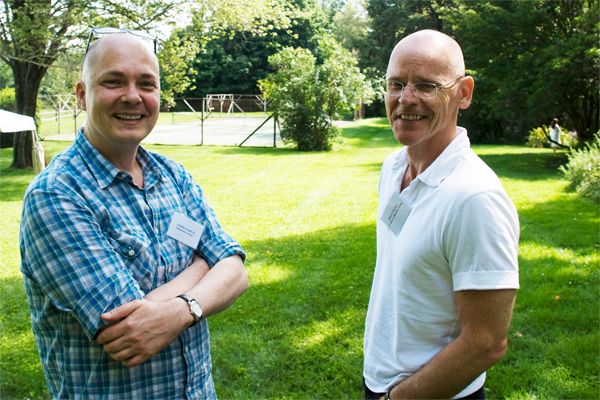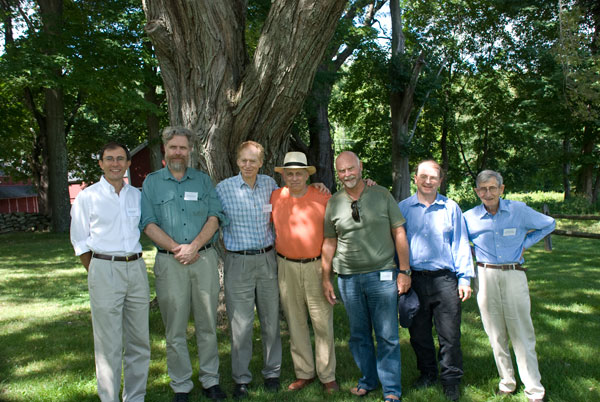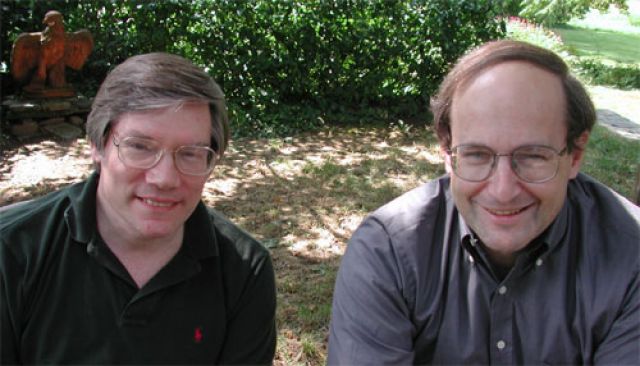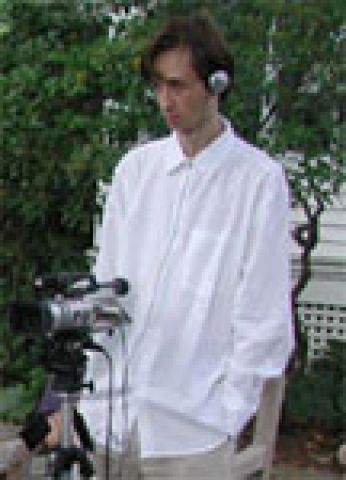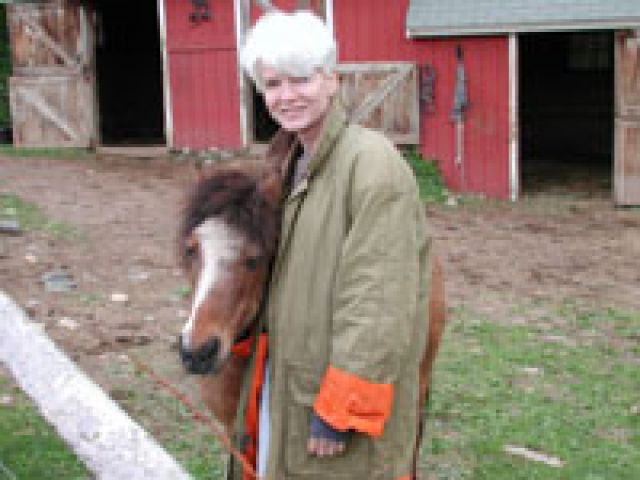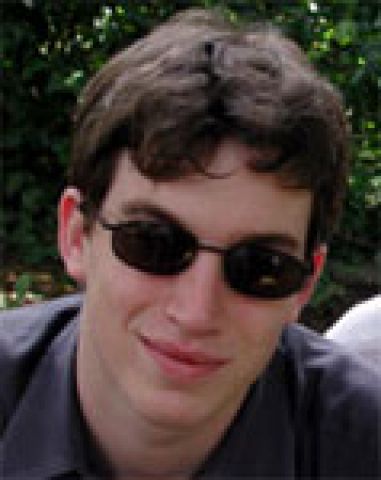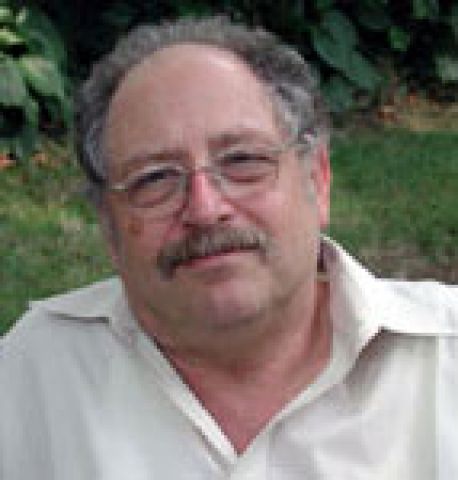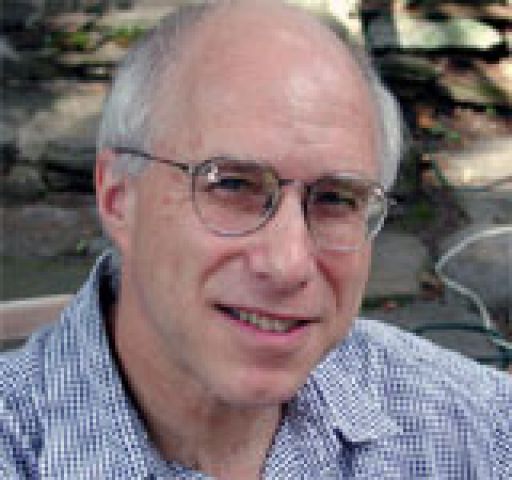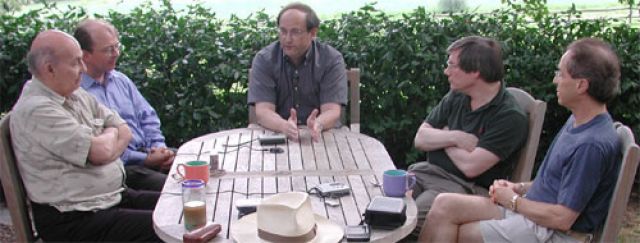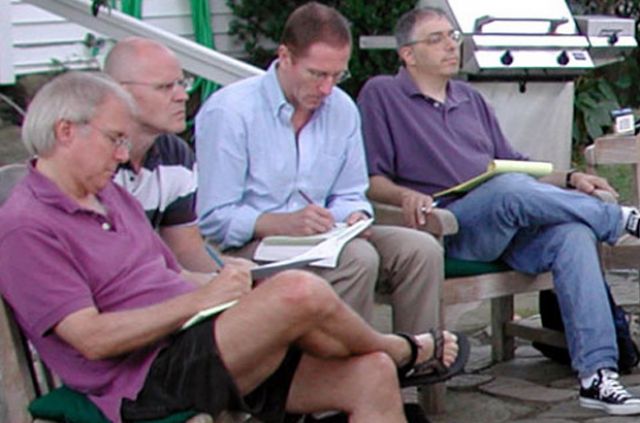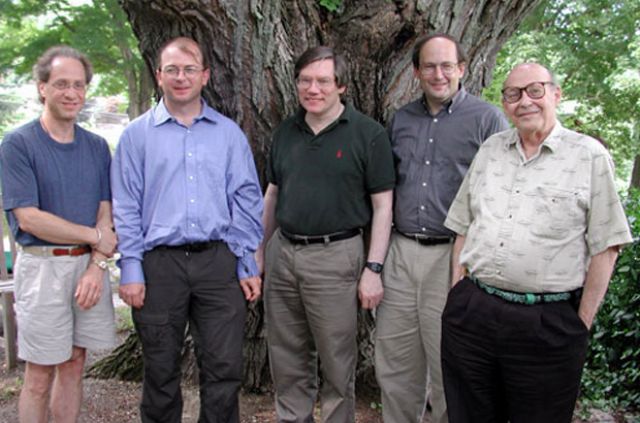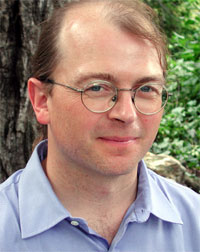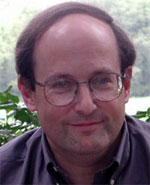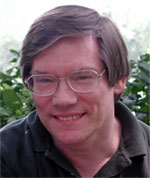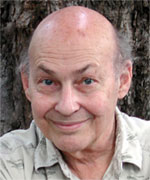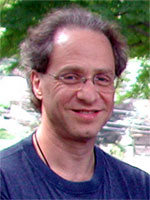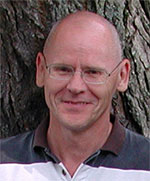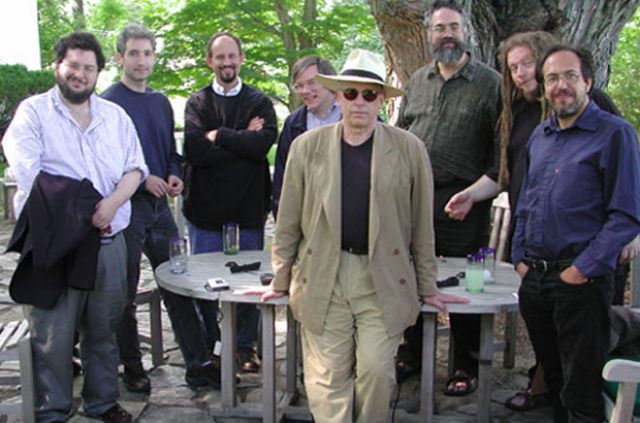Everything is up for grabs. Everything will change. There is a magnificent sweep of intellectual landscape right in front of us.
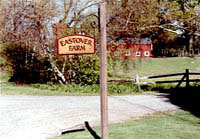
One aspect of our culture that is no longer open to question is that the most signigicant developments in the sciences today (i.e. those that affect the lives of everybody on the planet) are about, informed by, or implemented through advances in software and computation. This Edgeevent presented an opportunity for people in the various fields of computer science, cosmology, cognition, evolutionary biology, etc., to begin talking to each other, to become aware of interesting and important work in other fields.
Participants:
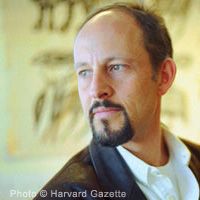 |
 |
 |
 |
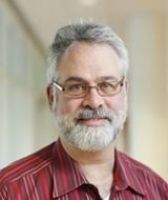 |
 |
 |
| Marc D. Hauser |
Lee Smolin |
Brain Greene |
Jaron Lanier |
Jordan Pollack |
David Gelernter |
Alan Guth |
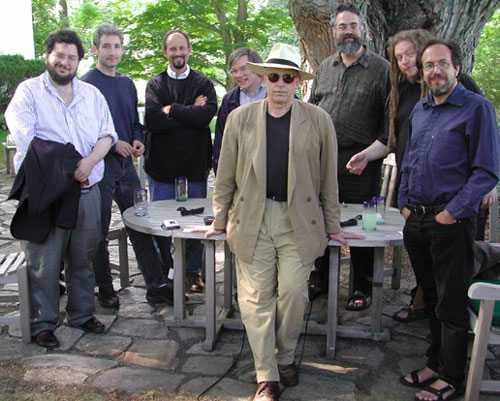
HAUSER, SMOLIN, GREENE, LANIER, POLLACK, GELERNTER, GUTH at the Edge "REBOOTING CIVILIZATION" meeting at Eastover Farm. Opening comments [12,000 words] and streaming video.
Software and computation are reinventing the civilized world —"rebooting civilization," in the words of David Gelernter. "It's a software-first world," notes Stanford AI expert Edward Feigenbaum, chief scientist of the U.S. Air Force in the mid-nineties. "It's not a mistake that the world's two richest men are pure software plays. Or that the most advanced fighter planes in the U.S. Air Force are bundles of software wrapped in aluminum shells, or that the most advanced bomber is run by computers and cannot be flown manually". Everybody in business today is in the software business. But what comes after software?
Experimental psychologist Steven Pinker speaks of "a new understanding that the human mind is a remarkably complex processor of information." To Pinker, our minds are "organs of computation." To philosopher Daniel C. Dennett, "the basic idea of computation, as formulated by the mathematicians John von Neumann and Alan Turing, is in a class by itself as a breakthrough idea." Dennett asks us to think about the idea that what we have in our heads is software, "a virtual machine, in the same way that a word processor is a virtual machine." Pinker and Dennett are talking about our mental life in terms of the idea of computation, not simply proposing the digital computer as a metaphor for the mind. Other scientists such as physicist Freeman Dyson disagree , but most recognize that these are big questions.??Physicist David Deutsch, a pioneer in the development of the quantum computer, points out that "the chances are that the technological implications of quantum computers, though large by some standards, are never going to be the really important thing about them. The really important thing is the philosophical implications, epistemological and metaphysical. The largest implication, from my point of view, is the one that we get right from the beginning, even before we build the first quantum computer, before we build the first cubit. The very theory of quantum computers already forces upon us a view of physical reality as a multiverse."??Computer scientist and AI researcher Rodney Brooks is puzzled that "we've got all these biological metaphors that we're playing around with — artificial immunology systems, building robots that appear lifelike — but none of them come close to real biological systems in robustness and in performance. They look a little like it, but they're not really like biological systems." Brooks worries that in looking at biological systems we are missing something that is already there — that has always been there. To Brooks, this might be called "the essence of life," but he is talking about a biochemical phenomenon, not a metaphysical one. Brooks is searching for a new conceptual framework that, like computation, does not involve any new physics or chemistry — a framework that gives us a different way of thinking about the stuff that's there. "We see the biological systems, we see how they operate," he says, "but we don't have the right explanatory modes to explain what's going on and therefore we can't reproduce all these sorts of biological processes. That to me right now is the deep question."
One aspect of our culture that is no longer open to question is that the most signigicant developments in the sciences today (i.e. the developments that affect the lives of everybody on the planet) are about, informed by, or implemented through advances in software and computation.
This Edge event is an opportunity for people in various fields such as computer science, cosmology, cognition, evolutionary biology, etc., to begin talking to each other, to become aware of interesting and important work in other fields.
— JB
MARC HAUSER
Some of the problems that we've been dealing with in the neurosciences and the cognitive sciences concerns the initial state of the organism. What do animals, including humans, come equipped with? What are the tools that they have to deal with the world as it is? There's somewhat of an illusion in the neurosciences that we have really begun to understand how the brain works. That's put quite nicely in a recent talk by Noam Chomsky. The title of the talk was "Language and the Brain."
Everybody's very surprised to hear him mention the brain word, since he's mostly referred to the mind. The talk was a warning to the neuroscientists about how little we know about, especially when it comes to understanding how the brain actually does language. Here's the idea Chomsky played with, which I think is quite right. Let's take a very simple system that is actually very good at a kind of computation: the honey bee. Here is this very little insect, tiny little brain, simple nervous system, that is capable of transmitting information about where it's been and what it's eaten to a colony and that information is sufficiently precise that the colony members can go find the food. We know that that kind of information is encoded in the signal because people in Denmark have created a robotic honey bee that you can plop in the middle of a colony, programmed to dance in a certain way, and the hive members will actually follow the information precisely to that location. Researchers have been able to understand the information processing system to this level, and consequently, can actually transmit it through the robot to other members of the hive. When you step back and say, what do we know about how the brain of a honeybee represents that information, the answer is: we know nothing. Thus, our understanding of the way in which a bee's brain represents its dance, its language, is quite poor. And this lack of understanding comes from the study of a relatively simple nervous system, especially when contrasted with the human nervous system.
So the point that Chomsky made, which I think is a very powerful one, and not that well understood, is that what we actually know about how the human brain represents language is at some level very trivial. That's not to say that neuroscientists haven't made quite a lot of impact on, for example, what areas of the brain when damaged will wipe out language. For example, we know that you can find patients who have damage to a particular part of the brain that results in the loss of representations for consonants, while other patients have damage that results in the loss of representations for vowels.
But we know relatively little about how the circuitry of the brain represents the consonants and vowels. The chasm between the neurosciences today and understanding representations like language is very wide. It's a delusion that we are going to get close to that any time soon. We've gotten almost nowhere in how the bee's brain represents the simplicity of the dance language. Although any good biologist, after several hours of observation, can predict accurately where the bee is going, we currently have no understanding of how the brain actually performs that computation.
The reason there have been some advances in the computational domain is there's been a lot of systems where the behavior showcases what the problem truly is, ranging from echolocation in bats to long distance navigation in birds. For humans, Chomsky's insights into the computational mechanisms underlying language really revolutionized the field, even though not all would agree with the approach he has taken. Nonetheless, the fact that he pointed to the universality of many linguistic features, and the poverty of the input for the child acquiring language, suggested that an innate computational mechanism must be at play. This insight revolutionized the field of linguistics, and set much of the cognitive sciences in motion. That's a verbal claim, and as Chomsky himself would quickly recognize, we really don't know how the brain generates such computation.
One of the interesting things about evolution that's been telling us more and more is that even though evolution has no direction, one of the things you can see, for example, within the primates is that a part of the brain that actually stores the information for a representation, the frontal lobes of our brain, has undergone quite a massive change over time. So you have systems like the apes who probably don't have the neural structures that would allow them to do the kind of computations you need to do language-processing. In our own work we've begun to look at the kinds of computations that animals are capable of, as well as the kind of computations that human infants are capable of, to try to see where the constraints lie.
Whenever nature has created systems that seem to be open-ended and generative, they've used some kind of system with a discrete set of recombinable elements. The question you can begin to ask in biology is, what kind of systems are capable of those kinds of computational processes. For example, many organisms seem to be capable of quite simple statistical computations, such as conditional probabilities that focus on local dependencies: if A, then B. Lots of animals seem capable of that. But when you step up to the next level in the computational hierarchy, one that requires recursion, you find great limitations both among animals and human infants. For example, an animal that can do if A then B, would have great difficulty doing if A to the N, then B to the N. We now begin to have a loop. If animals lack this capacity, which we believe is true, then we have identified an evolutionary constraint; humans seem to have evolved the capacity for recursion, a computation that liberated us in an incredible way.
It allows us to do mathematics as well as language. And this system of taking discrete or particulate elements and recombining them, is what gives genetics and chemistry their open ended structure. Given this pattern, an interesting question then is: what were the selective pressures that led to the evolution of a recursive system? Why is it that humans seem to be the only organisms on the planet, the only natural system, that has this capacity? What were the pressures that created it? Thinking about things like artificial intelligence, what would be the kinds of pressures on an artificial system that would get to that end point?
An interesting problem for natural biological systems as well as artificial systems is whether the two can meet, to try to figure out what kinds of pressures lead to a capacity for recursion, what are the building blocks that must be in place for the system to evolve? Comparative biology doesn't provide any helpful hints at present because we simply have two end points, humans that do it, and other organisms that don't. At this point in time, therefore, this evolutionary transition is opaque.
MARC D. HAUSER, a cognitive neuroscientist, is a professor in the departments of Psychology and the Program in Neurosciences at Harvard, where he is also a fellow of the Mind, Brain, and Behavior Program. He is the author of The Evolution of Communication, The Design of Animal Communication (with M. Konishi), and Wild Minds: What Animals Really Think.
LEE SMOLIN
As a theoretical physicist, my main concern is space, time and cosmology. The metaphor about information and computation is interesting. There are some people in physics who have begun to talk as if we all know that what's really behind physics is computation and information, who find it very natural to say things like anything that's happening in the world is a computation, and all of physics can be understood in terms of information. There's another set of physicists who have no idea what those people are talking about. And there's a third set — and I'm among them — who begin by saying we have no idea what you're talking about, but we have reasons why it would be nice if it was useful to talk about physics in terms of information.
I can mention two ways in which the metaphor of information and computation may be infiltrating into our thinking about fundamental physics, although we're a long way from really understanding these things. The first is that the mathematical metaphor and the conceptual metaphor of a system of relationships which evolves in time is something which is found in physics. It is also something that we clearly see when we talk to computer scientists and biologists and people who work on evolutionary theory, that they tend to model their systems in terms of networks where there are nodes and there are relationships between the nodes, and those things evolve in time, and they can be asking questions about the time evolution, what happens after a long time, what are the statistical properties of subsystems.
That kind of idea came into physics a long time ago with relativity theory and general relativity. The idea that all the properties of interest are really about relationships between things and not a relationship between some thing and some absolute fixed background that defines what anything means is an important idea and an old idea in physics. In classical general relativity, one sees the realization of the idea that all the properties that we observe are about relationships. Those of us who are interested in quantum gravity are thinking a lot about how to bring that picture, in which the world is an evolving network of relationships, into quantum physics.
And there are several different aspects of that. There are very interesting ideas around but they're in the stage of interesting ideas, interesting models, interesting attempts — it is science in progress.
That's the first thing. To the extent to which our physics will turn out to look like a network of relationships which are evolving in time, physics will look like some system that computational people or biologists using the computational metaphor may be studying. Part of that is the questions of whether nature is really discrete — that underlying the continuous notion of space and time there's really some discrete structure, that's also something that from different points of view — when we work on quantum gravity we find evidence that space and time are really discrete and are really made up on processes which may have some discrete character. But again, this is something in progress.
One piece of evidence that nature is discrete is something called the holographic principle. This leads some of us physicists to use the word information even when we don't really know what we're talking about but it is interesting and worth exposing. It comes from an idea called the Bekenstein Bound, a conjecture of Jacob Bekenstein that there is more and more theoretical evidence for. The Bekenstein Bound says that if I have a surface and I'm making observations on that surface —that surface could be my retina, or it could be some screen in front of me — I observe the world through the screen, at any one moment there's a limitation to the amount of information that could be observed on that screen.
First of all that amount of information is finite, and it's four bits of information per Planck area of the screen, where a Planck area is 10 to the minus 66 centimeters squared. And there are various arguments that if that bound were to be exceeded, in a world where there is relativity and black holes, then we would violate the Second Law of Thermodynamics. Since none of us wants to violate the Second Law of Thermodynamics, I think it's an important clue, and it says something important about the underlying discreteness of nature. It also suggests that information, although we don't know what information is, may have some fundamental place in physics.
The holographic principle, of which there are several versions by different people — the idea was invented by Dutch theoretical physicist Gerard 't Hooft — is that the laws of physics should be rewritten, or could be rewritten including dynamics, how things evolve in time, so we're no longer talking about things happening out there in the world in space, we're talking about representing systems that we observe in terms of the information as it evolves on the screen. The metaphor is that there's a screen through which we're observing the world. There are various claims that this idea is realized at least partly in several different versions of string theory or quantum gravity This is an idea there's a lot of interest in, but we really don't know whether it can be realized completely or not.
One extreme form of it, which I like, is that perhaps the way to read the Bekenstein Bound is not that there are two different things, geometry and flow of information and a law that relates them, but somehow we could try to envision the world as one of these evolving networks. What happens is processes where "information", whatever information is, flows from event to event, and geometry is defined by saying that the measure of the information capacity of some channel by which information is flowing, from the past to the future, would be the area of a surface, so that somehow geometry that is space would turn out to be some derived quantity, like temperature or density, and just the same way that temperature is a measure of the average energy of some particles, the area of some surface would turn out to be an approximate measure of the capacity of some channel in the world would fundamentally be information flow. It's an idea that some of us like to play with, but we have not yet constructed physics on those grounds, and it's not at all clear that it will work. This is a transition to a computational metaphor in physics — it's something which is in progress, and may or may not happen.
LEE SMOLIN, a theoretical physicist, is a founding member and research physicist at the Perimeter Institute in Waterloo Canada. He is the author ofThe Life of The Cosmos and Three Roads to Quantum Gravity.
BRIAN GREENE
Physics and everything we know in the world around us may really be tied to processes whose fundamental existence is not here around us, but rather exists in some distant bounding surface like some thin hologram, which by virtue of illuminating it in the right way can reproduce what looks like a 3-dimensional world. Perhaps our three dimensional world is really just a holographic illumination of laws that exist on some thin bounding slice, like that thin little piece of plastic, that thin hologram. It's an amazing idea, and I think is likely to be where physics goes in the next few years or in the next decade, at least when one's talking about quantum gravity or quantum string theory.
[Opening comments to come.]
BRIAN GREENE, professor of physics and of mathematics, at Columbia University is widely regarded for a number of groundbreaking discoveries in superstring theory. He is the author of The Elegant Universe: Superstrings, Hidden Dimensions, and the Quest for an Ultimate Theory.
JARON LANIER
One of the striking things about being a computer scientist in this age is that all sorts of other people are happy to tell us that what we do is the central metaphor of everything, which is very ego-gratifying. We hear from various quarters that our work can serve as the best way of understanding - if not in the present but any minute now because of Moore's law - of everything from biology to the economy to aesthetics, child-rearing, sex, you name it. I have found myself being critical of what I view as this overuse as the computational metaphor. My initial motivation was because I thought there was naive and poorly constructed philosophy at work. It's as if these people had never read philosophy at all and there was no sense of epistemological or other problems.
Then I became concerned for a different reason which was pragmatic and immediate: I became convinced that the overuse of the computational metaphor was actually harming the quality of the present-day design of computer systems. One example of that, the belief that people and computers are similar, the artificial intelligence mindset, has a tendency to create systems that are naively and overly automated. An example of that is the Microsoft word processor that attempts to retype what you've just typed, the notion of trying to make computers into people because somehow that agenda of making them into people is so important that if you jump the gun it has to be for the greater good, even if it makes the current software stupid.
There's a third reason to be suspicious of the overuse of computer metaphors, and that is that it leads us by reflection to have an overly simplistic view of computers. The particular simplification of computers I'm concerned with is imagining that Moore's Law applies to software as well as hardware. More specifically, that Moore's Law applies to things that have to have complicated interfaces with their surroundings as opposed to things that have simple interfaces with their surroundings, which I think is the better distinction.
Moore's Law is truly an overwhelming phenomenon; it represents the greatest triumph of technology ever, the fact that we could keep on this track that was predicted for all these many years and that we have machines that are a million times better than they were at the dawn of our work, which was just a half century ago. And yet during that same period of time our software has really not kept pace. In fact not only could you argue that software has not improved at the same rate as hardware, you could even argue that it's often been in retrograde. It seems to me that our software architectures have not even been able to maintain their initial functionality as they've scaled with hardware, so that in effect we've had worse and worse software. Most people who use personal computers can experience that effect directly, and it's true in most situations.
But I want to emphasize that the real distinction that I see is between systems with simple interfaces to their surroundings and systems with complex interfaces. If you want to have a fancy user interface and you run a bigger thing it just gets awful. Windows doesn't scale.
One question to ask is, why does software suck so badly? There are a number of answers to that. The first thing I would say is that I have absolutely no doubt that David Gelernter's framework of streams is fundamentally and overwhelmingly superior to the basis in which our current software is designed. The next question is, is that enough to cause it to come about? It really becomes a competition between good taste and good judgment on the one hand, and legacy and corruption on the other - which are effectively two words for the same thing, in effect. What happens with software systems is that the legacy effects end up being the overwhelming determinants of what can happen next as the systems scale.
For instance, there is the idea of the computer file, which was debated up until the early 80s. There was an active contingent that thought that the idea of the file wasn't a good thing and we should instead have a massive distributed data base with a micro-structure of some sort. The first (unreleased) version of the Macintosh did not have files. But Unix jumped the fence from the academic to the business world and it had files, and Macintosh ultimately came out with files, and the Microsoft world had files, and basically everything has files. At this point, when we teach undergraduates computer science, we do not talk about the file as an invention, but speak of it as if it were a photon, because it in effect is more likely to still be around in 50 years than the photon.
I can imagine physicists coming up with some reasons not to believe in photons any more, but I cannot imagine any way that we can tell you not to believe in files. We are stuck with the damn things. That legacy effect is truly astonishing, the sort of non-linearity of the costs of undoing decisions that have been made. The remarkable degree to which the arrow of time is amplified in software development in its brutalness is extraordinary, and perhaps one of the things that really distinguishes software from other phenomena.
Back to the physics for a second. One of the most remarkable and startling insights in 20th century thought was Claude Shannon's connection of information and thermodynamics. Somehow for all of these years working with computers I've been looking at these things and I've been thinking, "Are these bits the same bits Shannon was talking about, or is there something different?" I still don't know the answer, but I'd like to share my recent thoughts because I think this all ties together. If you wish to treat the world as being computational and if you wish to say that the pair of sunglasses I am wearing is a computer that has sunglass input and output- if you wish to think of things that way, you would have to say that not all of the bits that are potentially measurable are in practice having an effect. Most of them are lost in statistical effects, and the situation has to be rather special for a particular bit to matter.
In fact, bits really do matter. If somebody says "I do" in the right context that means a lot, whereas a similar number of bits of information coming in another context might mean much less. Various measurable bits in the universe have vastly different potentials to have a causal impact. If you could possibly delineate all the bits you would probably see some dramatic power law where there would be a small number of bits that had tremendously greater potential for having an effect, and a vast number that had very small potentials. It's those bits that have the potential for great effect that are probably the ones that computer scientists are concerned with, and probably Shannon doesn't differentiate between those bits as far as he went.
Then the question is how do we distinguish between the bits; what differentiates one from the other, how can we talk about them? One speculation is that legacy effects have something to do with it. If you have a system with a vast configuration space, as is our world, and you have some process, perhaps an evolutionary process, that's searching through possible configurations, rather than just a meandering random walk, perhaps what we see in nature is a series of stair steps where legacies are created that prohibit large numbers of configurations from every being searched again, and that there's a series of refinements.
Once DNA has won out, variants of DNA are very unlikely to appear. Once Windows has appeared, it's stuck around, and so forth. Perhaps what happens is that the legacy effect, which is because of the non-linearity of the tremendous expense of reversing certain kinds of systems. Legacies that are created are like lenses that amplify certain bits to be more important. This suggests that legacies are similar to semantics on some fundamental level. And it suggests that the legacy effect might have something to do with the syntax/semantics distinction, to the degree that might be meaningful. And it's the first glimmer of a definition of semantics I've ever had, because I've always thought the word didn't mean a damn thing except "what we don't understand". But I'm beginning to think what it might be is the legacies that we're stuck with.
To tie the circle back to the "Rebooting Civilization" question, what I'm hoping might happen is as we start to gain a better understanding of how enormously difficult, slow, expensive, tedious and rare an event it is to program a very large computer well; as soon as we have a sense and appreciation of that, I think we can overcome the sort of intoxication that overcomes us when we think about Moore's Law, and start to apply computation metaphors more soberly to both natural science and to metaphorical purposes for society and so forth. A well-appreciated computer that included the difficulty of making large software well could serve as a far more beneficial metaphor than the cartoon computer, which is based only on Moore's Law; all you have to do is make it fast and everything will suddenly work, and the computers-will-become-smarter than-us-if-you just-wait-for-20-years sort of metaphor that has been prevalent lately.
The really good computer simulations that do exist in biology and in other areas of science, and I've been part of a few that count, particularly in surgical prediction and simulation, and in certain neuroscience simulations, have been enormously expensive. It took 18 years and 5,000 patients to get the first surgical simulation to the point of testable usability. That is what software is, that's what computers are, and we should de-intoxicate ourselves from Moore's Law before continuing with the use of this metaphor.
JARON LANIER, a computer scientist and musician, is best known for his work in virtual reality. He is the lead scientist for the National Tele-Immersion Initiative, a consortium of universities studying the implications and applications of next-generation Internet technologies.
JORDAN POLLACK
The limits of software engineering have been clear now for about 20 years. We reached a limit in the size of the programs that we could build, and since then we've essentially just been putting them together in different packages and adding wallpaper. Windows is little more than just DOS with wallpaper - it doesn't really add any more fundamental complexity or autonomy to the process.
Being in AI, I see this "scale" of programming as the problem, not the speed of computers. Its not that we don't understand some principles, but we just can't write a program big enough. We have really big computers. You could hook up a Beowulf, you could hook up a Cray super computer to the smallest robot, and if you knew how to make the robot be alive, it would be alive, if all you needed was computer time. Moores law won't solve AI. Computer time is not what we need; we need to understand how to organize systems of biological complexity.
What I've been working with for the past decade or so has been this question of self-organization. How can a system of chemicals heated by the sun dissipate energy and become more and more complex over time? If we really understood that, we'd be able to build it into software, we'd be able to build it into electronics, and if we got the theory right, we would see a piece of software that ran and wasted energy in the form of computer cycles and became more and more complex over time, and perhaps would bust through the ten million line code limit. In this field, which I've been calling co-evolutionary learning, we have had limited successes in areas like games, problem-solving, and robotics, but no open ended self-organizing reaction. Yet.
It looks like biological complexity comes from the interplay of several different fields. Physics, Evolution, and Game theory. What's possible is determined by a set of rules. There are the immutable rules, systems that obey these rules, and create new systems which operate with rule-like behaviors that we think of as computation. Evolution enables a kind of exploration of the possible, putting together components in various ways, exploring a constrained space of possible designs. What was the fitness, what was the affordance, what was the reason that something arose? But that's only part of it. Physics (the rules) determine whats possible. Evolution (the variation) explores the possible. The Game determines what persists.
When we look at the results of our evolution and co-evolution software, we see that many early discoveries afford temporary advantages, but when something gets built on top of something, because it's part of a larger configuration, it persists, even tho it may be less optimal than other competitive discoveries.
I believe we're never going to get rid of the DOS file system, we're never going to get rid of the notepad text editor, we're never going to get rid of the Qwerty keyboard, because there are systems built on top of them. Just like the human eye has a blind spot.
At one point in human evolution there arose a bundle of nerves that twisted in the wrong direction and, even though it blocked a small bit of the visual field, nevertheless added some kind of advantage, and then layered systems built on top of that and locked the blind spot into being, and there's no way you can get rid of the blind spot now because it's essentially built in and supportive of other mechanisms.
We must look at the entire game to see what among the possible persists. Winners are not determined by the best technology, or by the best design. It's determined by a set of factors that says, whatever this thing is, it's part of a network, and that network supports its persistance. And as evolution proceeds, the suboptimal systems tend to stay in place. Just like vision has a blind spot, we're going to be stuck with technology upon which economic systems depend.
Studying more economics than a usual computer scientist, and reflecting back to the question of the change of society due to software, which John and I have called it the solvent - a social solvent - our naive notion of free enterprise, our naive notion of how competition works in economy is that there's supposed to be checks and balances. Supposedly a durable goods monopoly is impossible. To increase market share, the Tractor monopoly makes better tractors which sell more and last longer until the used market in perfectly good tractors at half the price stops them. As something gets bigger, as a company's products become more widely used, instead of locking into monopoly, there's supposed to be a negative limiting effect, in the fact that more competition comes in, the monopoly is stuck on its fat margins, and stumbles while competition chases profit down to a normal profit.
The way I described this stumbling is "monopoly necrosis." You become so dependent on the sales and margins of a product in demand that you can't imagine selling another one, even though technology is driving prices down. There are some great examples of this. The IBM PC junior was built to not compete with the Selective typewriter by putting in a rate limiter on the keyboard, so a kid couldn't type more than 2 characters a second! This was really the end of IBM. It wasn't Microsoft, it was this necrosis of not exploiting new technology which might erode the profit margins on the old ones. Ten years ago you could see the digital camera and the ink jet printer were going to come together and give you something that you could print pictures for pennies apiece. But Polaroid was getting a dollar a sheet for silver based instant film, and they couldn't see how to move their company in front of this wave that was coming. The storage companies, the big million-dollar terabyte disk companies are going to run into the same sort of thing, a terabyte for $5,000.
From the point of view of software, what I've noticed is that the software companies don't seem to suffer monopoly necrosis as traditional durable-goods theory would predict. They seem to just get bigger and bigger, because while a telephone company gets locked into its telephones or its wires or its interfaces, a tractor company starts to compete against its excellent used tractors, a software company can buy back old licences for more than they would sell for on the street, destroying the secondary market.
We see this in software, and it's because of the particular way that software has changed the equation of information property. The "upgrade" is the idea that you've bought a piece of software and now there's a new release and so - as a loyal customer - you should be able trade the old one in and buy the new one. What that ends up being is since what you bought wasn't the software but a permanent right to use the software, what you do when you upgrade, is forfeit your permanent right and purchase it again. If you don't upgrade, your old software won't work soon, so that permanent right you thought you owned will be worthless.
It seems to me that what we're seeing in the software area, and this is the scary part for human society, is the beginning of a kind of dispossession. People are talking about this as dispossession that only comes from piracy, like Napster and Gnutella where the rights of artists are being violated by people sharing their work. But there's another kind of dispossession, which is the inability to actually BUY a product. The idea is here: you couldn't buy this piece of software, you could only licence it on a day by day, month by month, year by year basis; As this idea spreads from software to music, films, books, human civilization based on property fundamentally changes.
The idea we hear of the big Internet in the sky with all the music we want to listen to, all the books and movies we want to read and watch on demand, all the software games and apps we want to use, sounds real nice, until you realize it isnt a public library, it is a private jukebox. You could download whenever you wanted over high-speed wireless 3-G systems into portable playing devices and pay only $50/month. But you can never own the ebook, you can never own the divx movie, you can never own the ASP software.
By the way, all the bookstores and music stores have been shut down.
It turns out that property isn't about possession after all, it is only about a relationship between an individual and their right to use something. Ownership is just "right to use until you sell" Your right to a house, or your liquid wealth, are stored as bits in an institutional computer - whether the computer is at the bureau of deeds in your town, whether the computer is at the bank, whether the computer is at the stock transfer agent. And property only works when transfers are not duplicative or lossy.
There is a fundamental difference between protecting the encryption systems for real currency and securities, and protecting encryptions systems for unlimited publishing. If the content industries prevail in gaining legal protection for renting infinite simultaneous copies, if we don't protect the notion of ownership, which includes the ability to loan, rent, and sell something when you're done with it, we will lose the ability to own things. Dispossession is a very real threat to civilization.
One of the other initiatives that I've been working on is trying to get my university at least to see that software and books and patents are really varieties of the same thing, and that they should normalize the intellectual property policy. Most universities give the copyright to your books back, and let professors keep all the royalties, even on a $1,000,000 book. But if you write a piece of software or you have a patent and it earns $50,000, the university tries to claim the whole thing. Very few universities get lucky with a cancer drug or Vitamin D, yet their IP policies drive innovation underground.
What I'm trying to do is separate academe from industry by giving academics back all their intellectual properties, and accept a tithe, like 9 percent of the value of all IP created on campus, including books and software and options in companies. I call it the "commonwealth of intellectual property," and through it a community of diverse scholars can share in some way in the success, drive, and luck of themselves and their colleagues. Most people are afraid of this, but I am certain it would lead to greater wealth and academic freedom for smaller universities like my own.
JORDAN POLLACK is a computer science and complex systems professor at Brandeis University. His laboratory's work on AI, Artificial Life, Neural Networks, Evolution, Dynamical Systems, Games, Robotics, Machine Learning, and Educational Technology has been reported on by the New York Times, Time, Science, NPR, Slashdot.org and many other media sources worldwide.
DAVID GELERNTER
Questions about the evolution of software in the big picture are worth asking. It's important that we don't lose sight of the fact that some of the key issues in software don't have anything to do with big strategic questions, they have to do with the fact that the software that's becoming ubiquitous and that so many people rely on is so crummy, and that for so many people software and in fact the whole world of electronics is a constant pain. The computers we're inflicting on people are more a cause for irritation and confusion and dissatisfaction and angst than a positive benefit. One thing that's going to happen is clearly a tactical issue; we're going to throw out the crummy, primitive software on which we rely, and see a completely new generation of software very soon.
If you look at where we are in the evolution of the desktop computer today, the machine is about 20 to 25 years old. Relatively speaking we're roughly where the airplane was in the late 1920s. A lot of work had been done but we were yet to see the first even quasi-proto modern airplane, which was the DC3 of 1935. In the evolution of desktop computing we haven't even reached DC3 level. We're a tremendously self-conscious and self-aware society, and yet we have to keep in mind how much we haven't done, and how crummy and primitive much of what we've built is. For most people a new electronic gadget is a disaster, another incomprehensible users manual or help set, things that break, don't work, that people can never figure out; features they don't need and don't understand. All of these are just tactical issues, but they are important to the quality of life of people who depend on computers, which increasingly is everybody.
When I look at where software is heading and what is it really doing, what's happening and what will happen with the emergence of a new generation of information-management systems, as we discard Windows and NT these systems that are 1960s, 1970s systems on which we rely today, we'll see a transition similar to what happened during the 19th century, when people's sense of space suddenly changed. If you compare the world of 1800 to the world of 1900, people's sense of space was tremendously limited and local and restricted in 1800. If you look at a New England village of the time, you can see this dramatically, everything is on site, a small cluster of houses, in which everything that needs to be done is done, and fields beyond, and beyond the fields a forest.
People traveled to some extent, but they didn't travel often, most people rarely traveled at all. The picture of space outside people's own local space was exceptionally fuzzy. Today, our picture of time is equally fuzzy; we have an idea of our local time and what happened today and yesterday, and what's going to happen next week, what happened the last few weeks, but outside of this, our view of time is as restricted and local as people's view of space was around 1800. If you look at what happened in the 19th century as transportation became available, cheap and ubiquitous, all of a sudden people developed a sense of space beyond their own local spaces, and the world changed dramatically. It wasn't just that people got around more and the economy changed and wealth was created. There was a tremendous change in the intellectual status of life. People moved outside their intellectual burrows; religion collapsed; the character of arts changed during the 19th century far more than it has during the 20th century or during any other century as the people's lives became fundamentally less internal, less spiritual, because they had more to do. They had places to go, they had things to see. When we look at the collapse of religion in the 19th century, it had far less to do with science than with technology, the technology of transportation that changed people's view of space and put the world at people's beck and call, in a sense. In 1800 this country was deeply religious; in 1900 religion had already become a footnote. And art had fundamentally changed in character as well.
What's going to happen, what software will do over the next few years this has already started to happen and will accelerate is that our software will be time-based, rather than space-based. We'll deal with streams of information rather than chaotic file systems that are based on 1940s idea of desks and file cabinets. The transition to a software world where we have a stream with a past, present and future is a transition to a world in which people have a much more acute sense of time outside their own local week, or month in which they now have a clear idea of what was different, why February of 1997 was different from February of 1994, which most people today don't have a clear picture of.
When we ask ourselves what the effect will be of time coming into focus the way space came into focus during the 19th century, we can count on the fact that the consequences will be big. It won't cause the kind of change in our spiritual life that space coming into focus did, because we've moved as far outside as we can get, pretty much. We won't see any further fundamental changes in our attitude towards art or religion all that has happened already. We're apt to see other incalculably large affects on the way we deal with the world and with each other, and looking back at this world today it will look more or less the way 1800 did from the vantage point of 1900. Not just a world with fewer gadgets, but a world with a fundamentally different relationship to space and time. From the small details of our crummy software to the biggest and most abstract issues of how we deal with the world at large, this is a big story.
"Streams" is a software project I've been obsessed with. In the early '90s it was clear to me that the operating system, the standard world in which I lived, was collapsing. For me and the academic community it was Unix; but it was the same in the world of Windows or the world of Mac or whatever world you were in. In the early 90s we'd been online solidly for at least a decade; I was a graduate student in the early 80s when the first desktop computers hit the stands. By the early 90s there was too much, it was breaking down. The flow of email, the number of files we had because we kept making more and they kept accumulating, we no longer threw them out every few years when we threw out the machine, they just grew to a larger and larger assemblage.
In the early 90s we were seeing electronic images, electronic faxes and stuff like that. The Web hadn't hit yet but it was clear to some of us what was coming and we talked about it and we wrote about it. The Internet was already big in the early 90s, and it was clear that the software we had was no good. It was designed for a different age. Unix was built at Bell Labs in the 1970s for a radically different technology world where computing power was rare and expensive, memories were small, disks were small, bandwidth was expensive, email was non-existent, the net was an esoteric fringe phenomenon. And that was the software we were using to run our lives in 1991, 1992. It was clear it was no good, it was broken, and it was clear that things were not going to get any better in terms of managing our online lives. It seemed to us at that point that we needed to throw out this 60s and 70s stuff.
The Unix idea of a file system copied so faithfully from the 1941 Steelcase file cabinet, which had its files and it had its folders, and the Xerox idea of a desktop with its icons of wastepaper baskets and stuff just like the offices that we were supposed to be leaving behind us, all this stuff copied faithful from the pre-electronic age. It was a good way to get started, but it was no good anymore. We needed something that was designed for computers. Forms and ways of doing business that were electronic and software-based, as opposed to being cribbed from what people knew how to do in 1944. They did well in 1944 but by 1991 it was no longer the way to operate in a software and electronic-based world.
It seemed to us that we wanted to arrange our stuff in time rather than in space. Instead of spreading it out on a virtual desktop in front of us we wanted all our information to accumulate in a kind of time line, or a diary or narrative with a past, present and future, or a stream, as we called the software. Every piece of information that came into my life, whether it was an email, or eventually a URL, or a fax or an image or a digital photo or a voice mail, or the 15th draft of a book chapter, all pieces of information would be plopped down at the end of a growing stream.
By looking at this stream I'd be looking at my entire information life, I would drop the absurd idea of giving files names the whole idea of names and directories had rendered itself ridiculous, and a burden. If we dropped everything into the stream and we provided powerful searching and indexing tools and powerful browsing tools, and we allowed time itself to guide us, we'd have a much better tool than trying to remember, am I looking for letter to John number 15B or am I looking for new new new letter to John prime. Instead I could say I'm looking for the letter to John I wrote last week, and go to last week and browse. It was clear that by keeping our stuff in a time line we could throw away the idea of names, we could throw away the idea of files and folders, we could throw away the desktop. Instead we'd have the stream, which was a virtual object that we could look at using any computer and no longer have to worry whether I put the file at work or at home, or in the laptop or the palm pilot. The stream was a virtual structure and by looking at it, tuning it in, I tuned in my life, and I could tune it in from any computer. It had a future as well, so if I was going to do something next Friday, I'd drop into the future, and next Friday would flow to the present, the present would flow to the past.
To make a long story short we built the software and the software was the basis of a world view, an approach to software and the way of dealing with information. It was also a commercial proposition. That's got intellectual content in a way because for so many of us we have been challenged, asked whether the intellectual center of gravity and technology has not moved away from the university into the private sector. I thought it was a rotten idea, I resisted this heavily. I had a bet with my graduate students in the mid-90s. I would try to fund this project by the usual government funding ways and they would try and fund it by private investors, and whoever got the money first, that's the way we would go. I thought there was no contest, I had all sorts of Washington funding contacts, but they beat me hands down. When I was trying to wangle invitations to Washington to talk about this stuff, they would get private investors to hop on a plane and fly to New Haven to see it. The difference in energy level between the private and the Washington sector was enormous. And bigots like myself, who didn't want to hear about private industry or private spending or the private sector, who believed in the university, as I still do, in principle were confronted with the fact that there was a radically higher energy level among people who had made a billion dollars and wanted to make another billion, than people who had got tenure and who were now bucking for what? A chair, or whatever.
The academic world was more restricted in terms of what it could offer greedy people, and greed drives the world, one of the things which you confront as you get older. Reluctantly. So this story is a commercial story also, and raises questions about the future of the university where the smart people are, where the graduate students go, where the dollars are, where the energy is, where the activity is. It hasn't been raised in quite the same way in some of the sciences as it has in technology. It certainly has become a big issue in biology and in medicine. The University, forgetting about software, and forgetting about the future of the stream, fiddling while Rome burns, or whatever it does, thinks that it's going to come to grips with the world by putting course notes on the Web. But we're dealing with something much bigger and much deeper than that.
What Yale charges for an education, as you know, is simply incredible. What it delivers is not worth what it charges. It gets by today on its reputation and in fact can get good jobs for its graduates. However, we're resting on our laurels. All these are big changes. And the changes that will happen in this nation's intellectual life when the university as we know it today collapses. The Yales and the Harvards, will do okay, but the 98% of the nation's universities that are not the Yales and Harvards and the MITs, when they collapse, intellectual life will be different, and that will be a big change, too. We're not thinking about this enough. And I know the universities are not. ?
DAVID GELERNTER is a professor of computer science at Yale and chief scientist at Mirror Worlds Technologies (New Haven). His research centers on information management, parallel programming, and artificial intelligence. The "tuple spaces" introduced in Nicholas Carriero and Gelernter's Linda system (1983) are the basis of many computer communication systems worldwide. Dr. Gelernter is the author of Mirror Worlds, The Muse in the Machine, 1939: The Lost World of the Fair, and Drawiing a Life: Surviving the Unabomber.
ALAN GUTH
Even though cosmology doesn't have that much to do with information, it certainly has a lot to do with revolution and phase transitions. In fact, it is connected to phase transitions in both the literal and the figurative sense of the phrase.
It's often said — and I believe this saying was started by the late David Schramm — that today we are in a golden age of cosmology. That's really true. Cosmology at this present time is undergoing a transition from being a bunch of speculations to being a genuine branch of hard science, where theories can be developed and tested against precise observations. One of the most interesting areas of this is the prediction of the fluctuations, the non-uniformities, in the cosmic background radiation, an area that I've been heavily involved in. We think of this radiation as being the afterglow of the heat of the Big Bang. One of the remarkable features of the radiation is that it's uniform in all directions, to an accuracy of about one part in a hundred thousand, after you subtract the term that's related to the motion of the earth through the background radiation.
I've been heavily involved in a theory called the inflationary universe, which seems to be our best explanation for this uniformity. The uniformity is hard to understand. You might think initially that maybe the uniformity could be explained by the same principles of physics that cause a hot slice of pizza to get cold when you take it out of the oven; things tend to come to a uniform temperature. But once the equations of cosmology were worked out, so that one could calculate how fast the universe was expanding at any given time, then physicists were able to calculate how much time there was for this uniformity to set in.
They found that, in order for the universe to have become uniform fast enough to account for the uniformity that we see in the cosmic background radiation, information would have to have been transferred at approximately a hundred times the speed of light. But according to all our theories of physics, nothing can travel faster than light, so there's no way that this could have happened. So the classical version of the Big Bang theory had to simply start out by assuming that the universe was homogeneous — completely uniform — from the very beginning.
The inflationary universe theory is an add-on to the standard Big Bang theory, and basically what it adds on is a description of what drove the universe into expansion in the first place. In the classic version of the Big Bang theory, that expansion was put in as part of the initial assumptions, so there's no explanation for it whatever. The classical Big Bang theory was never really a theory of a bang; it was really a theory about the aftermath of a bang. Inflation provides a possible answer to the question of what made the universe bang, and now it looks like it's almost certainly the right answer.
Inflationary theory takes advantage of results from modern particle physics, which predicts that at very high energies there should exist peculiar kinds of substances which actually turn gravity on its head and produce repulsive gravitational forces. The inflationary explanation is the idea that the early universe contains at least a patch of this peculiar substance. It turns out that all you need is a patch; it can actually be more than a billion times smaller than a proton. But once such a patch exists, its own gravitational repulsion causes it to grow, rapidly becoming large enough to encompass the entire observed universe.
The inflationary theory gives a simple explanation for the uniformity of the observed universe, because in the inflationary model the universe starts out incredibly tiny. There was plenty of time for such a tiny region to reach a uniform temperature and uniform density, by the same mechanisms through which the air in a room reaches a uniform density throughout the room. And if you isolated a room and let it sit long enough, it will reach a uniform temperature as well. For the tiny universe with which the inflationary model begins, there is enough time in the early history of the universe for these mechanisms to work, causing the universe to become almost perfectly uniform. Then inflation takes over and magnifies this tiny region to become large enough to encompass the entire universe, maintaining this uniformity as the expansion takes place.
For a while, when the theory was first developed, we were very worried that we would get too much uniformity. One of the amazing features of the universe is how uniform it is, but it's still by no means completely uniform. We have galaxies, and stars and clusters and all kinds of complicated structure in the universe that needs to be explained. If the universe started out completely uniform, it would just remain completely uniform, as there would be nothing to cause matter to collect here or there or any particular place.
I believe Stephen Hawking was the first person to suggest what we now think is the answer to this riddle. He pointed out — although his first calculations were inaccurate — that quantum effects could come to our rescue. The real world is not described by classical physics, and even though this was very "high-brow" physics, we were in fact describing things completely classically, with deterministic equations. The real world, according to what we understand about physics, is described quantum-mechanically, which means, deep down, that everything has to be described in terms of probabilities.
The "classical" world that we perceive, in which every object has a definite position and moves in a deterministic way, is really just the average of the different possibilities that the full quantum theory would predict. If you apply that notion here, it is at least qualitatively clear from the beginning that it gets us in the direction that we want to go. It means that the uniform density, which our classical equations were predicting, would really be just the average of the quantum mechanical densities, which would have a range of values which could differ from one place to another. The quantum mechanical uncertainly would make the density of the early universe a little bit higher in some places, and in other places it would be a little bit lower.
So, at the end of inflation, we expect to have ripples on top of an almost uniform density of matter. It's possible to actually calculate these ripples. I should confess that we don't yet know enough about the particle physics to actually predict the amplitude of these ripples, the intensity of the ripples, but what we can calculate is the way in which the intensity depends on the wavelength of the ripples. That is, there are ripples of all sizes, and you can measure the intensity of ripples of different sizes. And you can discuss what we call the spectrum — we use that word exactly the way it's used to describe sound waves. When we talk about the spectrum of a sound wave, we're talking about how the intensity varies with the different wavelengths that make up that sound wave.
We do exactly the same thing in the early universe, and talk about how the intensity of these ripples in the mass density of the early universe varied with the wavelengths of the different ripples that we're looking at. Today we can see those ripples in the cosmic background radiation. The fact that we can see them at all is an absolutely fantastic success of modern technology. When we were first making these predictions back in 1982, at that time astronomers had just barely been able to see the effect of the earth's motion through the cosmic background radiation, which is an effect of about one part in a thousand. The ripples that I'm talking about are only one part in a hundred thousand — just one percent of the intensity of the most subtle effect that it had been possible to observe at the time we were first doing these calculations.
I never believed that we would ever actually see these ripples. It just seemed too far fetched that astronomers would get to be a hundred times better at measuring these things than they were at the time. But, to my astonishment and delight, in 1992 these ripples were first detected by a satellite called COBE, the Cosmic Background Explorer, and now we have far better measurements than COBE, which had an angular resolution of about 7 degrees. This meant that you could only see the longest wavelength ripples. Now we have measurements that go down to a fraction of a degree, and we're getting very precise measurements now of how the intensity varies with wavelength, with marvelous success.
About a year and a half ago, there was a spectacular set of announcements from experiments called BOOMERANG and MAXIMA, both balloon-based experiments, which gave very strong evidence that the universe is geometrically flat, which is just what inflation predicts. (By flat I don't mean two-dimensional; I just mean that the three-dimensional space of the universe in not curved, as it could have been, according to general relativity.) You can actually see the curvature of space in the way that the pattern of ripples has been affected by the evolution of the universe. A year and a half ago, however, there was an important discrepancy that people worried about; and no one was sure how big a deal to make out of it. The spectrum they were measuring was a graph that had, in principle, several peaks. These peaks had to do with successive oscillations of the density waves in the early universe, and a phenomenon called resonance that makes some wavelengths more intense than others. The measurements showed the first peak beautifully, exactly where we expected it to be, with just the shape that was expected. But we couldn't actually see the second peak.
In order to fit the data with the theories, people had to assume that there were about ten times as many protons in the universe as we actually thought, because the extra protons would lead to a friction effect that could make the second peak disappear. Of course every experiment has some uncertainty — if an experiment is performed many times, the results will not be exactly the same each time. So we could imagine that the second peak was not seen purely because of bad luck. However, the probability that the peak could be so invisible, if the universe contained the density of protons that is indicated by other measurements, was down to about the one percent level. So, it was a very serious-looking discrepancy between what was observed and what was expected. All this changed dramatically for the better about 3 or 4 months ago, with the next set of announcements with more precise measurements. Now the second peak is not only visible, but it has exactly the height that was expected, and everything about the data now fits beautifully with the theoretical predictions. Too good, really. I'm sure it will get worse before it continues to get better, given the difficulties in making these kinds of measurements. But we have a beautiful picture now which seems to be confirming the inflationary theory of the early universe.
Our current picture of the universe has a new twist, however, which was discovered two or three years ago. To make things fit, to match the observations, which are now getting very clear, we have to assume that there's a new component of energy in the universe that we didn't know existed before. This new component is usually referred to as "dark energy." As the name clearly suggests, we still don't know exactly what this new component is. It's a component of energy which in fact is very much like the repulsive gravity matter I talked about earlier — the material that drives the inflation in the early universe. It appears that, in fact, today the universe is filled with a similar kind of matter. The antigravity effect is much weaker than the effect that I was talking about in the early universe, but the universe today appears very definitely to be starting to accelerate again under the influence of this so-called dark energy.
Although I'm trying to advertise that we've understood a lot, and we have, there are still many uncertainties. In particular, we still don't know what most of the universe is made out of. There's the dark energy, which seems to comprise in fact about 60% of the total mass/energy of the universe. We don't know what it is. It could in fact be the energy of the vacuum itself, but we don't know that for a fact. In addition, there's what we call dark matter, which is another 30%, or maybe almost 40%, of the total matter in the universe; we don't know what that is, either. The difference between the two is that the dark energy causes repulsive gravity and is smoothly distributed; the dark matter behaves like ordinary matter in terms of its gravitational properties — it's attractive and it clusters; but we don't know what it's made of. The stuff we do know about — protons, neutrons, ordinary atoms and molecules — appear to comprise only about 5% of the mass of the universe.
The moral of the story is we have a great deal to learn. At the same time, the theories that we have developed so far seem to be working almost shockingly well.
ALAN GUTH, father in the inflationary theory of the Universe, is Victor F. Weisskopf Professor of Physics at MIT; author of The Inflationary Universe: The Quest for a New Theory of Cosmic Origins.
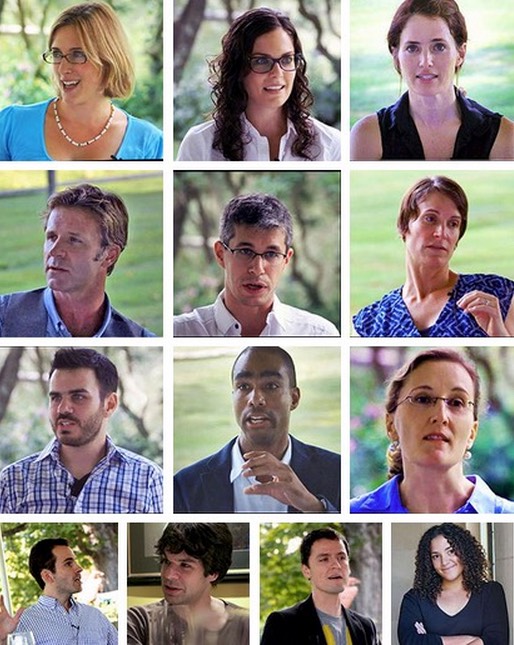

 Download PDF of Manuscript [5]
Download PDF of Manuscript [5] 


